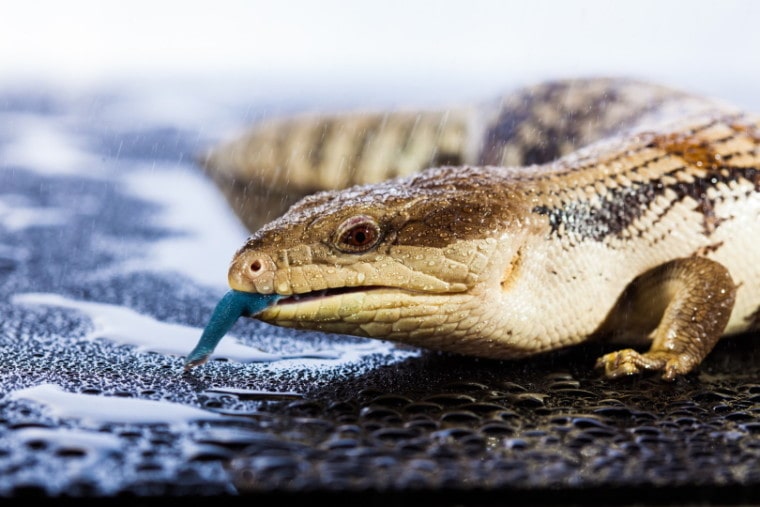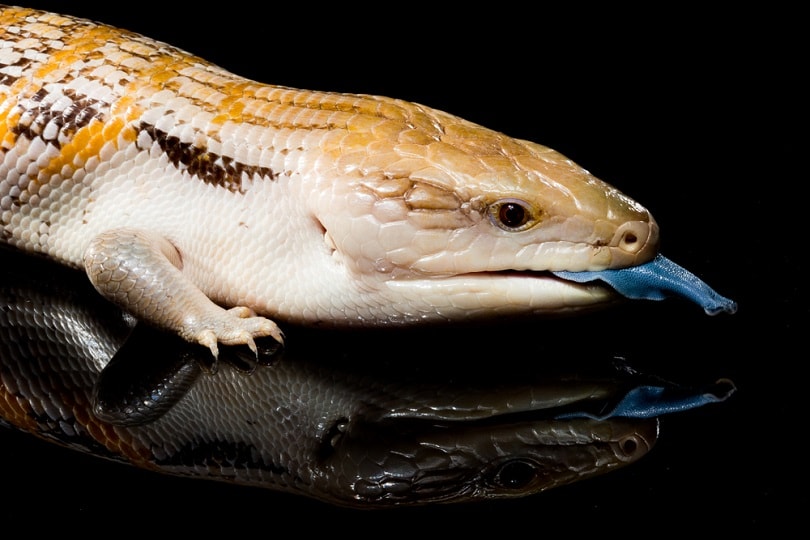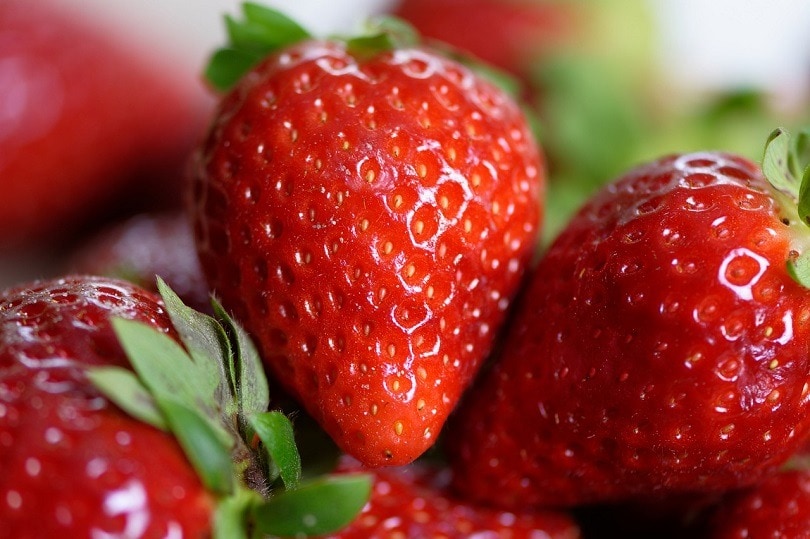
The blue-tongued skink is the prominent and most popular pet skink. As the largest member of this lizard family, it’s distinguishable by its trademark bright blue tongue.
In the wild, they live in semi-deserts, scrublands, and mixed woodland areas. However, they can also be captive-bred as pets.
Whether bred in the wild or living as pets, these creatures feed on various plants and animals. Blue-tongued skinks are omnivores, making it easy to feed them.
So, what specific foods do these lizards eat? Let’s take a closer look.

Origin and History
All blue-tongued skinks are native to the Australasia region; they are present in mainland Australia and parts of Asia, Papua New Guinea, and a few other Indonesian islands. This lizard species has become extremely popular in recent years due to its berry-blue tongue and viability.
Blue tongues can be found in different sizes, varieties, and colors. There are ten types or subspecies: Western, Centralian, Northern, Eastern, Blotched, Indonesian, Pygmy, Kei Island, Tanimbar Island, and Merauke. All these varieties come in different sizes but are identifiable by the blue tongue.
Due to the growing popularity, blue-tongued skinks are readily available in the pet trade. Despite this, some of the skink varieties, such as the pygmy blue tongues, are listed as endangered species because of smuggling and illegal trade.
Some blue-tongued species are highly coveted for their unique and beautiful patterns. These varieties will tend to fetch a higher price even though they are common in the wild. The ban on legal exports for this pet has resulted in increased breeding and smuggled specimens to meet the demand among blue-tongued pet lovers.

Physical Attributes
Apart from the prominent blue tongues, these skinks have a distinct appearance. Their scales have a glossy appearance and come in various patterns, colors, and markings. Blue-tongued skinks can have various colors from cream, golden yellow, red, orange, silver-grey, black, to brown.
The patterns will depend on the species of the skink. The scales help keep out sand, dirt, and any debris. After every six weeks, they shed the scales. This shedding process takes a lot of energy, reducing normal food metabolism.
Blue Tongue Skinks as Pets
Blue-tongues are popular because they make good pets if they are captive-bred. Unlike the wild species, captive-bred pets will become quite friendly and form a bond with their caregivers. Keeping one of these creatures requires you to provide the necessary optimal conditions for them to live comfortably.
These pet skinks need an enclosure with the right temperature and lighting settings and a proper diet. With an expected lifespan of 15-20 years, these creatures will be in your home for quite a long time as captive skinks.
Therefore, you’ll need to learn how to handle them. With regular gentle handling, they become tolerant and enjoy being petted.
As omnivores, they can feed on a diet of animal protein or green leafy produce mixed with fruits, legumes, and other vegetables.

What Do Blue Tongue Skinks Eat as Pets?
Once you bring a blue-tongued skink home, you need to ensure you offer them the best food to keep them healthy.
Here’s a guide on what you should feed them.
Meat
Blue-tongued skinks need a lot of protein. For younger skinks below 12 months, protein should make up 70-80% of their diet, whereas adults can get 50-60%.
Protein is good for the young ones to prevent their scales from deforming. When adults consume too much protein, they are more prone to obesity and kidney issues.
The protein diet is made up of insects, fresh meat, eggs, and dog or cat food. When feeding your skink meat, you can either cook it or serve it raw, depending on your pet’s preference. However, cooked meat has a reduced risk of contamination or poisoning.
You can buy the skink some chicken, turkey, beef, especially the liver and heart, which are very nutritious.
Blur-tongued skinks can also eat boneless fish and served in tiny bite-sized pieces. Most meats should be added as a treat because the skink’s main protein source is insects.

Eggs
You can also feed your skink chicken or quail eggs. They can either be raw, scrambled, or boiled, depending on which option you prefer.
However, when feeding your pet eggs, you should keep in mind that eggs are high in fat and cholesterol, leading to obesity problems. Therefore, they should only be given occasionally as a treat, about once a month.
In addition, also ensure you don’t add oil, butter, milk, salt, or dairy products. Skinks have a problem processing dairy and could get very sick. Also, raw eggs can be riskier; therefore, it’s better to serve them boiled or scrambled.
Insects
You can feed your blue-tongued insects from a can or let the lizard hunt. Your pet will enjoy feeding on roaches, grasshoppers, locusts, snails, hornworms, earthworms, silkworms, crickets, and superworms.
Gut-loading your feeder insects is essential for your skink’s diet. Before feeding, you should gut load all feeder insects for at least 24 hours. If you are buying them from the breeder, they should come pre-gut loaded.

Vegetables
Like proteins, vegetables should make up approximately half of your pet’s diet. Plant-based foods are essential in maintaining the health of your skink.
Some of the vegetables you can feed your pet include squash, basil, kale, oregano, peppermint, rosemary, fresh okra and corn, grated carrot, cauliflower, celery, green beans, beets, turnips, collards, bell peppers, and endives. Like other omnivores, the blue-tongued skink might avoid the vegetables.
The best way to ensure they eat is by cutting the vegetables into small bite-size pieces. The plant matter should be incorporated in 3 out of 4 meals.
Fruits

Although fruits are a large part of the skink’s natural diet, they shouldn’t make up more than 10% of the diet. These creatures love berries; hence you should feed them blueberries, blackberries, raspberries, and strawberries. You can also supplement with apples, pears, or melon.
Dog or Cat Food
You can feed your skink cat and dog food as a healthy addition to the diet. However, you need to offer these products occasionally and know which one to use.
Cat food is very high in protein since they are carnivorous. Feeding your skink this food increases the risk of weight gain and obesity.
It also doesn’t contain any other nutrients such as vegetables; therefore, it’s better to stick to dog food, especially for adults. You can feed the juvenile ones cat food once a week because they need protein.
When choosing the right dog food, go for high-quality premium brands that use real ingredients. These brands have a mix of nutrients that provides a natural balance of what the skink would eat in the wild.
Supplements
Apart from the natural food, your skink could benefit from supplementation. To keep your skink’s bones strong, add a pinch of calcium powder to their diet. For adults, add this once a week and make it two times a week for the younger skinks.
Also, if you are not using UVB lighting in your skink’s shelter, you’ll need a supplement that has high amounts of Vitamin D3.

What to Avoid Feeding Your Blue-Tongued Skinks
Even though these creatures are omnivores, some foods could be toxic to their systems that you should avoid. Here are some of the foods.
Toxic Insects
Insects make up most of the skink’s diet. However, some insects are toxic to your pet and should be avoided. Don’t feed your skink lightning bugs, scorpions, centipedes, wild-caught bugs, spiders, monarch butterflies, caterpillars, and ants.
Toxic Vegetables and Fruits
Avocado, onion, eggplant, rhubarb, buttercups, potatoes, tulips are considered toxic. Other vegetables such as tomatoes, spinach, leeks, and mushrooms are either very acidic or have high levels of unwanted nutrients. Fruits such as pineapples, oranges, kiwi, bananas, and tangerines are highly acidic and very high in oxalates.
Foods with a high acidity cause stomach upset for your pet. Oxalates are also harmful to your blue-tongued skink because they bind calcium in the body and inhibit its absorption. This becomes risky because skinks need calcium to grow and maintain healthy bones.


What Do Blue Tongue Skinks Eat in the Wild?
Blue tongued skinks in the wild feeding habits depend on the specific species. While most of them live in the semi-deserts, woodlands, or scrubland, the foods they eat will also depend on the region and what’s available in their habitat.
In the wild, blue-tongued skinks are scavengers and consume meat from dead animals and cattle dung. All of the subspecies consume insects such as grasshoppers, beetles, worms, woodlice, and ants. They also feed on snails and any other smaller creatures available in their habitat.
Since they are omnivores, they’ll also consume plant matter in the wild. They consume berries, leaves, seasonal flowers, and weeds such as dandelion, roses, and hibiscus. Unlike when they are captive-bred, blue-tongued skunks don’t necessarily stick to a healthy diet but eat to survive.
Because of this, wild-collected skinks may be fussy in their diet when taken in as pets and are not particularly pleasant. Wild-caught skinks will maintain a defensive attitude for years, will hiss, and bite when handled, therefore don’t make good pets.
Captive-bred skinks get varied and healthier diets, resulting in a far much healthier skink than the wild cousins. Thanks to the healthy lifestyle, pet skinks will tend to live longer than their wild counterparts.
How Much Should You Feed Your Blue Tongue Skink?
As a pet, blue tongue skinks will thrive on a diet of around 40-45% protein; fresh vegetables and greens should make up roughly 50% of their diet, with fruits making up 5-10% of the diet. Juvenile skinks should feed on more protein, mostly made up of live feeder insects that have been gut-loaded.
Each serving of food should be equal to about 1-2 tablespoons.

When Should You Feed Your Blue Tongue Skink?
How often you feed your pet will vary with age. The nutritional needs change as they grow and mature. Baby skinks up to 3 months baby should feed 2 to 3 times each day, six days a week. During this age, you should feed them daily with insects and a small portion of greens.
From age 3 to 8 months, your skink will need less food. You should feed them three times a week. As long as they are healthy, they can now be fed with insects, greens, and vegetables every other day. Past 8 months, they are now adults and need to feed 1-2 times per week.
Why Is Your Blue Tongue Skink Not Eating?
Blue-tongued skinks are generally good feeders. But once you notice that your pet is not eating normally, there may be an issue. Let’s look at some reasons.
Skin Shedding Season
Blue-tongued skinks tend to refuse food during the skin shedding period. The shedding takes up a lot of energy; therefore, most of them wait until they are done shedding to eat. This should not be a major problem if your pet is healthy.
Illness
Like other reptiles, blue tongue skinks get internal parasites that can cause the body to weaken. Your vet can detect this using a fecal test. Skinks tend to avoid food when taking medication; therefore, they might not eat until they are healthy.
Vivarium Temperature
Your blue-tongued skink might be refusing to eat due to an issue within its enclosure. These creatures are very sensitive to temperatures and lighting. Therefore, you should always check whether the temperatures in the basking zone are as they should be.
Also, check the UVB to keep your pet comfortable.


Final Thoughts
Blue Tongue Skinks thrive well in the wild and as pets. As omnivores, they feed on a variety of foods that includes animal and plant matter.
These creatures survive on meat from dead animals, insects, wild berries, and leaves in their natural habitat. Therefore, once you adopt one as a pet, you should ensure their diet also contains a balance of these nutrients.
Captive-bred skinks get a more balanced diet which significantly increases their average lifespan.
Featured Image Credit: Martin Valigursky, Shutterstock







